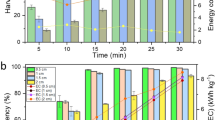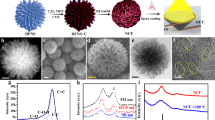Abstract
The recurring and unpredictable occurrences of water blooms have emerged as an escalating global threat to both the environment and water resources. Superior to the unsatisfactory post-bloom treatment techniques, the proactive strategy of reducing microalgae density in an economical and safe manner holds promise for effective water bloom control and prevention; however, it remains an important challenge. Here we report an efficient microalgae extraction mediated by a sustainable microalgae grabber (SMAG), which fully integrates tailored water depth suspending, electrostatic microalgae capture and magnetic collection. More importantly, the photothermal conversion capability of SMAG allows for the denaturation of extracellular polymeric substances, enabling on-demand desorption of microalgae for desired multiple reuses. Through the cyclic operation of these recyclable SMAGs, it demonstrates a remarkable microalgae removal efficiency of 94% and photothermal-driven spontaneous desorption, with a recovery efficiency of over 90%. Furthermore, a customized self-cruising floating device has been designed for the large-scale implementation of SMAGs, showcasing solar-powered sustainable microalgae extraction and harvesting in natural water bodies. The customizable and scalable SMAG offers a refreshing perspective in reinvigorating industries related to proactive water bloom prevention and microalgae resource capitalization.
This is a preview of subscription content, access via your institution
Access options
Subscribe to this journal
Receive 12 digital issues and online access to articles
$99.00 per year
only $8.25 per issue
Buy this article
- Purchase on Springer Link
- Instant access to full article PDF
Prices may be subject to local taxes which are calculated during checkout





Similar content being viewed by others
Data availability
The data supporting the findings of this study are available within the paper (and its Supplementary Information).
References
Maso, M. & Garcés, E. Harmful microalgae blooms (HAB); problematic and conditions that induce them. Mar. Pollut. Bull. 53, 620–630 (2006).
Sellner, K. G., Doucette, G. J. & Kirkpatrick, G. J. Harmful algal blooms: causes, impacts and detection. J. Ind. Microbiol. Biotechnol. 30, 383–406 (2003).
Hou, X. et al. Global mapping reveals increase in lacustrine algal blooms over the past decade. Nat. Geosci. 15, 130–134 (2022).
Berdalet, E. et al. Marine harmful algal blooms, human health and wellbeing: challenges and opportunities in the 21st century. J. Mar. Biol. Assoc. UK 96, 61–91 (2016).
Chapra, S. C. et al. Climate change impacts on harmful algal blooms in US freshwaters: a screening-level assessment. Environ. Sci. Technol. 51, 8933–8943 (2017).
Riebesell, U. et al. Toxic algal bloom induced by ocean acidification disrupts the pelagic food web. Nat. Clim. Change 8, 1082–1086 (2018).
Dai, Y. et al. Coastal phytoplankton blooms expand and intensify in the 21st century. Nature 615, 280–284 (2023).
Treuer, G., Kirchhoff, C., Lemos, M. C. & McGrath, F. Challenges of managing harmful algal blooms in US drinking water systems. Nat. Sustain. 4, 958–964 (2021).
Glibert, P. M. & Burford, M. A. Globally changing nutrient loads and harmful algal blooms: recent advances, new paradigms, and continuing challenges. Oceanography 30, 58–69 (2017).
Anantapantula, S. S. & Wilson, A. E. Most treatments to control freshwater algal blooms are not effective: meta-analysis of field experiments. Water Res. 243, 120342 (2023).
Williams, P. Jl. B. & Laurens, L. M. Microalgae as biodiesel & biomass feedstocks: review & analysis of the biochemistry, energetics & economics. Energy Environ. Sci. 3, 554–590 (2010).
Qu, M. et al. Algal blooms: proactive strategy. Science 346, 175–176 (2014).
Darvehei, P., Bahri, P. A. & Moheimani, N. R. Model development for the growth of microalgae: a review. Renew. Sust. Energy Rev. 97, 233–258 (2018).
Bhola, V., Swalaha, F., Ranjith Kumar, R., Singh, M. & Bux, F. Overview of the potential of microalgae for CO2 sequestration. Int. J. Environ. Sci. Technol. 11, 2103–2118 (2014).
Zhao, B. & Su, Y. Process effect of microalgal–carbon dioxide fixation and biomass production: a review. Renew. Sust. Energy Rev. 31, 121–132 (2014).
Zhu, L. Biorefinery as a promising approach to promote microalgae industry: an innovative framework. Renew. Sust. Energy Rev. 41, 1376–1384 (2015).
Barros, A. I., Gonçalves, A. L., Simões, M. & Pires, J. C. Harvesting techniques applied to microalgae: a review. Renew. Sust. Energy Rev. 41, 1489–1500 (2015).
Singh, G. & Patidar, S. Microalgae harvesting techniques: a review. J. Environ. Manage. 217, 499–508 (2018).
Abu-Shamleh, A. & Najjar, Y. S. Optimization of mechanical harvesting of microalgae by centrifugation for biofuels production. Biomass Bioenergy 143, 105877 (2020).
Zhao, F. et al. Microalgae harvesting by an axial vibration membrane: the mechanism of mitigating membrane fouling. J. Membrane Sci. 508, 127–135 (2016).
Zhao, Z., Muylaert, K. & Vankelecom, I. F. Combining patterned membrane filtration and flocculation for economical microalgae harvesting. Water Res. 198, 117181 (2021).
Laamanen, C. A., Ross, G. M. & Scott, J. A. Flotation harvesting of microalgae. Renew. Sust. Energy Rev. 58, 75–86 (2016).
Alkarawi, M. A., Caldwell, G. S. & Lee, J. G. Continuous harvesting of microalgae biomass using foam flotation. Algal Res. 36, 125–138 (2018).
Vandamme, D., Foubert, I. & Muylaert, K. Flocculation as a low-cost method for harvesting microalgae for bulk biomass production. Trends Biotechnol. 31, 233–239 (2013).
Matter, I. A. et al. Flocculation harvesting techniques for microalgae: a review. Appl. Sci. 9, 3069 (2019).
Balaji-Prasath, B. et al. Methods to control harmful algal blooms: a review. Environ. Chem. Lett. 20, 3133–3152 (2022).
Suparmaniam, U. et al. Insights into the microalgae cultivation technology and harvesting process for biofuel production: a review. Renew. Sust. Energy Rev. 115, 109361 (2019).
Van Dolah, F. M. Marine algal toxins: origins, health effects, and their increased occurrence. Environ. Health Perspect. 108, 133–141 (2000).
Li, N. et al. Electrostatic charges on microalgae surface: mechanism and applications. J. Environ. Chem. Eng. 10, 107516 (2022).
Zhang, C. et al. Synthesis of iron nanometallic glasses and their application in cancer therapy by a localized Fenton reaction. Angew. Chem. Int. Ed. 55, 2101–2106 (2016).
Wang, X. Q. et al. Nanophotonic-engineered photothermal harnessing for waste heat management and pyroelectric generation. ACS Nano 11, 10568–10574 (2017).
Grinstaff, M. W., Salamon, M. B. & Suslick, K. S. Magnetic properties of amorphous iron. Phys. Rev. B 48, 269 (1993).
Zhang, C. et al. Cryogenic exfoliation of non‐layered magnesium into two‐dimensional crystals. Angew. Chem. Int. Ed. 58, 8814–8818 (2019).
Harke, M. J. et al. A review of the global ecology, genomics, and biogeography of the toxic cyanobacterium, microcystis spp. Harmful Algae 54, 4–20 (2016).
Xiao, R. & Zheng, Y. Overview of microalgal extracellular polymeric substances (EPS) and their applications. Biotechnol. Adv. 34, 1225–1244 (2016).
Domínguez-Martín, M. A. et al. Structures of a phycobilisome in light-harvesting and photoprotected states. Nature 609, 835–845 (2022).
Zakar, T., Laczko-Dobos, H., Toth, T. N. & Gombos, Z. Carotenoids assist in cyanobacterial photosystem II assembly and function. Front. Plant Sci. 7, 295 (2016).
Maxwell, K. & Johnson, G. N. Chlorophyll fluorescence-a practical guide. J. Exp. Bot. 51, 659–668 (2000).
Béchet, Q., Laviale, M., Arsapin, N., Bonnefond, H. & Bernard, O. Modeling the impact of high temperatures on microalgal viability and photosynthetic activity. Biotechnol. Biofuels 10, 1–11 (2017).
Coskun, C., Oktay, Z. & Dincer, I. Estimation of monthly solar radiation distribution for solar energy system analysis. Energy 36, 1319–1323 (2011).
Zhang, C., Lu, W., Xu, Y., Zeng, K. & Ho, G. W. Mechanistic formulation of inorganic membranes at the air–liquid interface. Nature 616, 293–299 (2023).
Acknowledgements
This work was supported by the Zhejiang Provincial Natural Science Foundation of China (grant no. LY22B030011 (Y.X.)) and a National Natural Science Foundation of China (grant no. 21805243 (Y.X.)).
Author information
Authors and Affiliations
Contributions
Y.X. conceived the idea and supervised the project, analysed the data and wrote the paper. M.W. performed the experiments with assistance from X.X. C.Z. and G.W.H. contributed to the mechanistic discussion, device design and paper revision. H.F. offered some suggestions.
Corresponding authors
Ethics declarations
Competing interests
The authors declare no competing interests.
Peer review
Peer review information
Nature Water thanks Yanhui Ao, Pratyoosh Shukla, Wen Zhang and the other, anonymous, reviewer(s) for their contribution to the peer review of this work.
Additional information
Publisher’s note Springer Nature remains neutral with regard to jurisdictional claims in published maps and institutional affiliations.
Supplementary information
Supplementary Information
Notes 1–7, Figs. 1–33, Tables 1–3 and references.
Source data
Source Data Fig. 2
Statistical source data.
Source Data Fig. 3
Statistical source data.
Source Data Fig. 4
Statistical source data.
Source Data Fig. 5
Statistical source data.
Rights and permissions
Springer Nature or its licensor (e.g. a society or other partner) holds exclusive rights to this article under a publishing agreement with the author(s) or other rightsholder(s); author self-archiving of the accepted manuscript version of this article is solely governed by the terms of such publishing agreement and applicable law.
About this article
Cite this article
Wu, M., Zhang, C., Xie, X. et al. Sustainable microalgae extraction for proactive water bloom prevention. Nat Water 2, 172–182 (2024). https://doi.org/10.1038/s44221-024-00195-9
Received:
Accepted:
Published:
Issue Date:
DOI: https://doi.org/10.1038/s44221-024-00195-9



